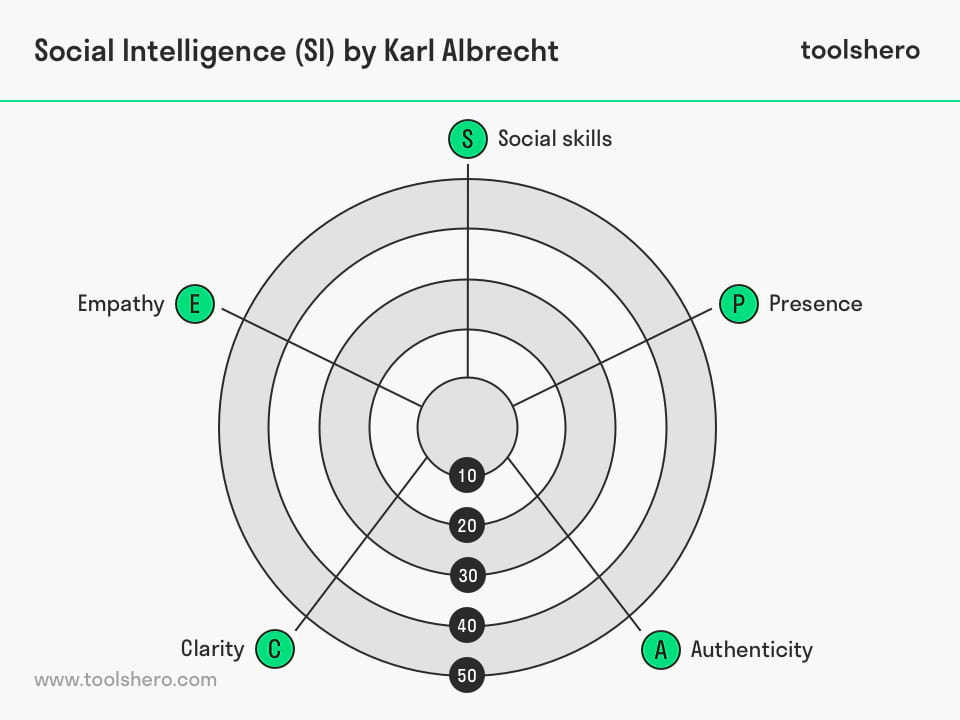Social Intelligence (SI) explained

Social Intelligence (SI): this article explains the concept of Social Intelligence (SI), developed by Karl Albrecht in a practical way. Next to what it is (definition), this article also highlights the nurturing behaviour, the Six dimensions of the Social Intelligence, the profile and the diagram. After reading it, you will understand the basics of this communications skills theory. Enjoy reading!
What is Social Intelligence?
In 2003, the American psychologist Karl Albrecht wrote Social intelligence, the New Science of Success.
The definition of Social Intelligence
In it, Karl Albrecht defined Social Intelligence (SI) as the characteristic of employees and supervisors to be able to interact well with others and achieve full cooperation.
It is about interpersonal skills and the behaviour people display toward each other. According to Albrecht, this behaviour can have a ‘toxic’ effect and a ‘nurturing’ effect. Social Intelligence is about a number of things.
First, it is about the sensitivity to and insight into the needs and interests of others; this is called a social radar. In addition, it is about several practical skills, which can be used for successful interaction between people. Being aware of certain situations and knowing how to act are part of that.
To a certain extent, Social Intelligence is also focused on self-assessment and reflection and becoming aware of one’s own observations and response patterns. With that, Social Intelligence, offers the opportunity to effectively deal with complex social relations and/ or environments and negotiate.
Social Intelligence and nurturing behaviour
In his book, Albrecht talks about the toxic and nurturing effects of behaviour Toxic behaviour leads to people feeling angry, frustrated, guilty or other negative and inadequate emotions.
Nurturing behaviour on the other hand, makes people feel appreciated, respected, competent and motivated. That is the foundation of Social Intelligence. The more someone is subjected to a continuing pattern of toxic behaviour, the lower his level of Social Intelligence will be and the less able he will be to connect people to each other and influence them effectively.
A continuing pattern of nurturing behaviour will lead to a higher degree of effective interaction with others.
Six dimensions of the Social Intelligence
Karl Albrecht developed a model and test to measure SI. It can be very useful for business and professional organisations where the employees deal with a lot of interpersonal interactions.
Compare these dimensions to the six sides of a dice; each side plays an equal part and is therefore proportional to the other sides. Each side represents a dimension and together all six make up the total competency that is necessary for social intelligence:
Abstract
This leads to conceptual reasoning. People are able to present themselves well through verbal communication and they are also able to communicate mathematical and symbolic information
Social
This leads to successful cooperation with others in different contexts.
Practical
With this, someone is able to solve problems with common sense and not think in limitations, but in possibilities.
Emotional
This results in self-awareness and reflection and the ability to come achieve individual improvement and empathise with others.
Aesthetic
This leads to appreciation and respect for other people’s solutions, designs and ideas.
Kinaesthetic
With this, someone is able to use their whole body; listen well, look at people, communicating and so on.
Social Intelligence Profile (SIP) and the SPACE model
According to Albrecht, social intelligence is measurable via a test. It includes identifying important interaction skills and then assessing their behaviour. Human interactions take place in specific contexts.
SI is about someone being able to distinguish these situations and contexts from each other and react to them differently and behave accordingly. The different observable behaviours are the indicators of SI.
This results in a Social Intelligence Profile (SIP). An SIP analyses social intelligence through different perspectives, with each observing the social interaction from a certain perspective.
The so-called SPACE model can be helpful with this. It subdivides the different behaviours in five basing skill categories based on the previously discussed dimensions:
1. Social Skills
These are about social awareness and the ability to understand the context of a situation and to know how one should behave in that situation.
2. Presence
This is about the presence and the attitude towards other people. Is someone able to present himself well and express his personality in a consistent way, no matter the situation. If someone behaves differently from how he really is, he lacks presence.
3. Authenticity
Being authentic or genuine is the level to which someone is experienced as honest and ethical. Whether someone’s behaviour is in line with his personal values or if he pretends to be someone else.
4. Clarity
This is about the how someone communicates clearly and unambiguously. To what extent is someone able to express his ideas clearly, effectively and efficiently.
In addition, it includes a whole range of communicative skills such as listening, providing feedback, paraphrasing and using metaphors to clarify or help explain something.
5. Empathy
This is about the level to which someone is able to understand others and empathise with other people’s situations. That allows someone to really build a connection with others and approach them respectfully. It even goes beyond the conventional definition of empathy; it is about a mutual feeling between two people.
Social Intelligence: the SPACE model
By dividing a circle chart into five slices that each include one of the five basic skill categories, the SI Profile can be completed.

Figure 1 – SPACE model (Albrecht)
A person filling out the Social Intelligence Profile for self-evaluation will answer a range of questions that relate to the different behaviours. Each category has five scores, varying from little to a lot. The results are shown in a diagram shaped like a spider’s web.
The higher the scores, the higher the level of Social Intelligence. It should be noted that social intelligence only applies if there is an even distribution across the five basic skill categories. If one category is missing or if the score is particularly low, it is a good idea to focus on this area and practice with it.
It’s Your Turn
What do you think? Have you ever heard of Social Intelligence (SI)? Do you recognize the practical explanation or do you have more suggestions? What are your success factors for effectively dealing with complex social relations and/ or environments and negotiate?
Share your experience and knowledge in the comments box below.
More information
- Albrecht, K. (2006, 2003). Social intelligence: The new science of success. John Wiley & Sons.
- Crowne, K. A. (2009). The relationships among social intelligence, emotional intelligence and cultural intelligence. Organization Management Journal, 6(3), 148-163.
- Goleman, D. (2007). Social intelligence. Random house.
How to cite this article:
Mulder, P. (2018). Social Intelligence (SI). Retrieved [insert date] from Toolshero: https://www.toolshero.com/communication-methods/social-intelligence/
Original publication date: 01/31/2018 | Last update: 04/09/2024
Add a link to this page on your website:
<a href=”https://www.toolshero.com/communication-methods/social-intelligence/”>Toolshero: Social Intelligence (SI)</a>












